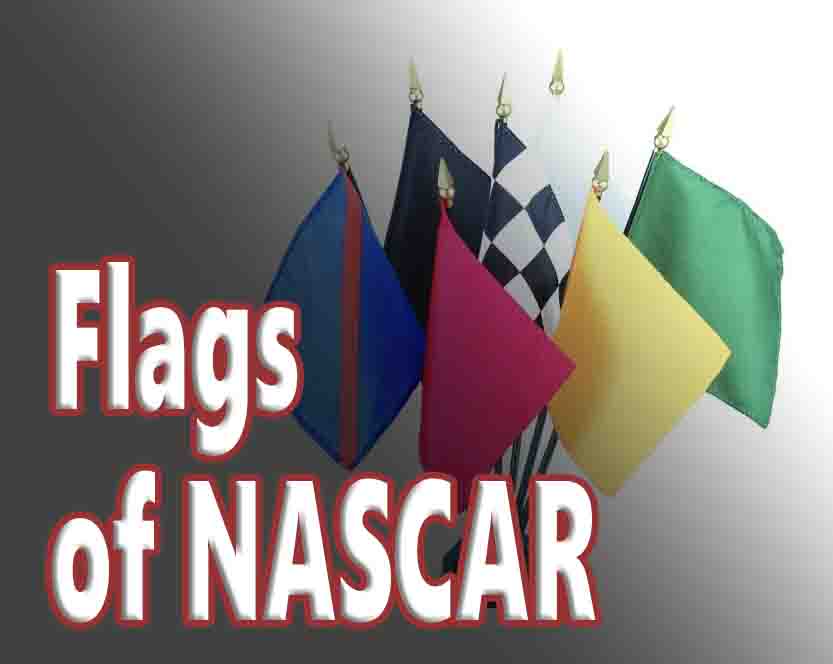You may not know that there are different types of flags, but if you’ve ever looked closely at the flags used in auto racing, you know what kind of flags you. It’s true, NASCAR is famous for its use of flags to symbolize the start and finish of every race.
It’s vital to know what each flag means when you’re racing, so it’s essential to understand the meaning of each flag that’s raised at each racetrack. It is difficult to communicate the different scenarios of football / soccer with only 15 different flags and combinations.
Here’s a breakdown of what every flag means in a NASCAR race.

Table of Contents
The History of Flags in Auto Racing
Motorsports officials have used signal flags to communicate with athletes since the beginning of organized racing. It’s essential to use flags to communicate racing stages and coarse conditions because it allows racing officials to stand back from the action so they won’t be on the track or in the way of cars. Even street racing and amateur racing levels use flags to effectively communicate the start and end of a race since they’re easily visible to all drivers.
The NASCAR Flags
NASCAR flags have become a symbol of American patriotism. Many Americans consider them to be symbols of freedom, strength, and success. There are many different kinds of flags that you can use to represent your country. And, there are also various ways to display these flags.
NASCAR uses a series of 15 flags to communicate with drivers and teams. The flagperson, a NASCAR official, is responsible for raising the blue flag at a NASCAR race and blowing a horn to let the drivers know they’ve entered the final part of the race. That location isn’t easy for drivers to see but is in view of the pit road and race team, who often have spotters watching the flagman and communicating track conditions to their drivers.
NASCAR racing flags have various meanings and I’ll explain them here.
Green Flag
A green flag is one of the easiest flags to understand because it’s a “go” signal. The flagman waves the green flag twice during the race.
Yellow Flag
Many racing fans call the yellow flag a “caution flag” because it appears when the race is under caution. This usually happens after a car crash or racing incident that leaves debris on the track, which makes it dangerous to race at full speed. The yellow flag signals that the pace car is about to begin racing.
Red Flag
The danger of using shared mutable state and racing against other threads in your application is that race conditions are so unsafe that the race must stop. Red flags may indicate weather conditions, severe incidents, track problems, or even sabotage. The race is going to end after a caution period. The cars will make a lap or two around the track in order to get to a safe place on pit road.
Black Flag
NASCAR officials will wave the red flag for those who run out of fuel or blow a tire or get into an accident. The black flag is usually used to indicate that the driver has committed an illegal maneuver while on the track. A NASCAR driver must go to the pits after a collision, because they may incur a penalty that will take them out of the race.
Blue Flag
NASCAR officials only use the blue flag when racing on a road course. During road races, they don’t issue a yellow or red flag to indicate dangers off the track or to warn drivers to slow down. You may have a damaged vehicle part or a disabled race car. This flag is not a caution flag, and the race is proceeding at full speed when displayed.
White Flag
The driver in front of you flashes their lights, signaling that it’s time for your team. This signal encourages racers to power up and race to the finish line.
Blue Flag with a Yellow Stripe
This sign tells lapped cars that the race leaders are rapidly approaching and need to move out of the way so they can keep moving forward.
Red Flag with a Diagonal Yellow Stripe
This flag isn’t one of the few flags flown by a flagman. It appears at the entrance to the pit lane and lets drivers know that the pit road is closed. Officials will remove the flag after the pits reopens.
Black Flag with Crossed White Stripes
This is a yellow flag. It means there is an incident on track and that drivers must return to the pits.
Yellow and Red Striped Flag
Officials wave this flag at road courses to let other drivers know that there’s debris on the track.
Green and White Checkered Flag
When a race is finished, you usually have several different stages. They are different because of their length and their placement along the course.
Black and White Checkered Flag
The black and white checkered flag is one of the most famous flags in car racing. The starting gun fires, the cars roar down the track, and the flagman waves the checkered flag.
Red and Black Flag Together
This sign informs a flagman that he can stop waving his flag at the end of a practice or qualifying session.
Two Checkered Flags Together
The flagman waves two checkered flags at the same time when the race is half over.
Green-White-Checkered Flag
It’s a combination of flags that only come out during a specific race scenario. An incident occurred during the last two laps of the race. This incident means that we’ll have a red flag and then have a 2-lap shootout to the finish line. Once the race restarts, the flagman will wave the green flag, signaling the start of the first lap.
Some signals are really complicated, but if you pay attention to the flag and use a different route for the following turn, you’ll avoid confusing the driver ahead of you. That’s why it’s so important for teams to have spotters that can help interpret the signs and effectively guide the driver through the course.
Conclusion
Race cars are not for everyone. In fact, they’re extremely challenging, expensive, and dangerous. Whether you’re hosting a party, attending a party, or watching a party, everyone should know how to stay safe and avoid injury while enjoying themselves.
